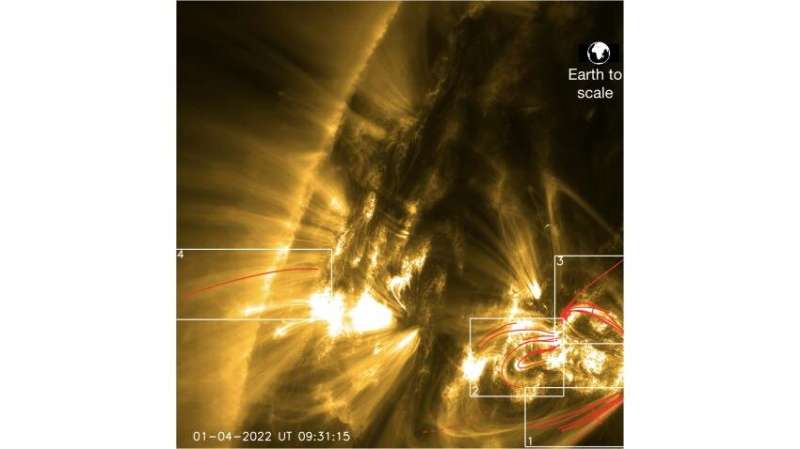A group of European astronomers, led by Northumbria University in Newcastle, has made an intriguing discovery: “shooting stars” on the sun. Using data from the European Space Agency’s Solar Orbiter (SolO), the researchers have identified meteor-like fireballs occurring within the stunning plasma displays known as coronal rain. Lead author Patrick Antolin, Assistant Professor at Northumbria University, will present the findings at the National Astronomy Meeting (NAM 2023).
Coronal rain, although not actual water, is a phenomenon where the sun’s fiery material condenses due to localized temperature drops. The corona, which is the outermost layer of the sun’s atmosphere, consists of gas at incredibly high temperatures. When the temperature suddenly drops, super-dense clumps of plasma, up to 250 kilometers wide, form and descend back to the sun due to gravity, reaching speeds of over 100 kilometers per second.
The research will be published in a special issue of Astronomy & Astrophysics dedicated to SolO’s close perihelion to the sun. The study provides the best spatial resolution ever obtained of the solar corona, thanks to SolO’s close proximity to the sun during its spring 2022 mission, where it came within 49 million kilometers, which is about a third of the distance between Earth and the sun.
In addition to capturing high-resolution images of the coronal rain, SolO also observed the heating and compression of gas beneath these clumps. The intense heat below the clumps, which lasts for a few minutes as they descend, causes a spike in intensity.

On Earth, “shooting stars” occur when meteoroids enter our atmosphere at high speeds and burn up. However, the sun’s corona is different. It is thin and low in density, so the clumps of coronal rain do not lose much material as they descend. Scientists believe that most of these “shooting stars” make it to the solar surface intact. SolO’s observations have enabled the first-ever observations of these impacts, which result in a brief, brightening effect and the release of material and shockwaves that heat the gas above.
In Earth’s atmosphere, shooting stars and meteors leave a visible trace behind their path due to the ablation process, where heated material strips off parts of the object. This happens to comets orbiting the sun as well. However, in the solar corona, the magnetic field prevents ablation from occurring. Instead, falling gas becomes partially ionized and follows the magnetic field lines, acting as giant funnels. The compression and heat underneath prevent the clumps from producing tails, making the phenomenon more challenging to witness on the sun.
Lead author Patrick Antolin explains, “The inner solar corona is so hot we may never be able to directly explore it with a spacecraft. However, SolO orbits close enough to the sun to detect small-scale phenomena within the corona, like the effect of the rain on the corona. This allows us to indirectly study the coronal environment, which is crucial for understanding its composition and thermodynamics. The discovery of coronal rain is a significant advancement in solar physics as it provides important insights into the mysteries surrounding the sun’s heating to millions of degrees.”
Antolin adds humorously, “If humans were alien beings capable of living on the sun’s surface, we would constantly enjoy extraordinary views of shooting stars, but we would need to watch out for our heads.”
These observations by SolO have also confirmed previous research indicating that coronal rain is more widespread than previously thought.
More information:
P. Antolin et al, Extreme-ultraviolet fine structure and variability associated with coronal rain revealed by Solar Orbiter/EUI HRIEUV and SPICE, Astronomy & Astrophysics (2023). DOI: 10.1051/0004-6361/202346016. On arXiv: DOI: 10.48550/arxiv.2305.11691
Provided by Royal Astronomical Society
Follow Google News
Denial of responsibility! TechCodex is an automatic aggregator of the all world’s media. In each content, the hyperlink to the primary source is specified. All trademarks belong to their rightful owners, and all materials to their authors. For any complaint, please reach us at – [email protected]. We will take necessary action within 24 hours.

Jessica Irvine is a tech enthusiast specializing in gadgets. From smart home devices to cutting-edge electronics, Jessica explores the world of consumer tech, offering readers comprehensive reviews, hands-on experiences, and expert insights into the coolest and most innovative gadgets on the market.

